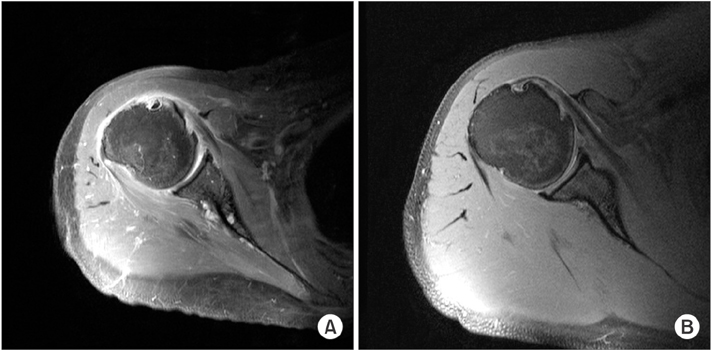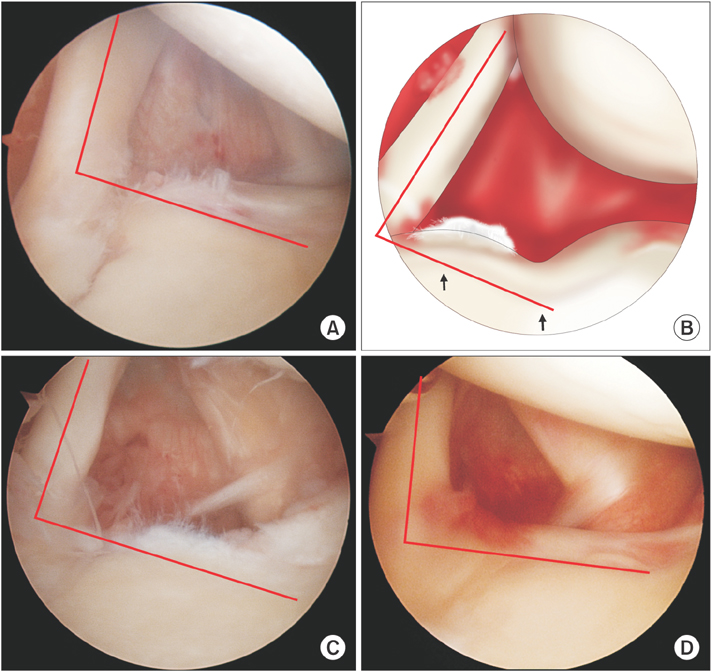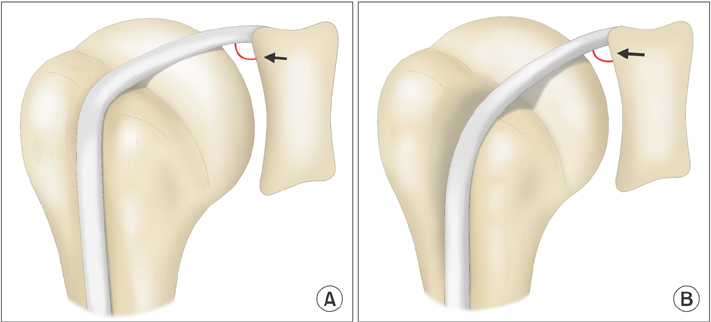Clin Orthop Surg.
2017 Sep;9(3):332-339. 10.4055/cios.2017.9.3.332.
Arthroscopic Evaluation of Subluxation of the Long Head of the Biceps Tendon and Its Relationship with Subscapularis Tears
- Affiliations
-
- 1Department of Orthopaedic Surgery, Inje University Ilsan Paik Hospital, Goyang, Korea.
- 2Department of Orthopaedic Surgery, Samsung Medical Center, Sungkyunkwan University School of Medicine, Seoul, Korea. shoulderyoo@gmail.com
- KMID: 2412270
- DOI: http://doi.org/10.4055/cios.2017.9.3.332
Abstract
- BACKGROUND
The purpose of this study was to evaluate the angle between the long head of the biceps tendon (LHBT) and the glenoid during arthroscopic surgery and its correlation with biceps subluxation on magnetic resonance imaging (MRI). Furthermore, we evaluated the relationship of this angle with subscapularis tears and biceps pathologies.
METHODS
MRI and arthroscopic images of 270 consecutive patients who had undergone arthroscopic surgery were retrospectively evaluated. On MRI, 60 shoulders with biceps subluxation and 210 shoulders without subluxation were identified. On the arthroscopic view from the posterior portal, the angle between the LHBT and the glenoid (biceps-glenoid angle) was measured. The biceps-glenoid angle, tears of the LHBT, degenerative superior labrum anterior to posterior (SLAP) lesions, and presence of a subscapularis tear were compared according to the presence of biceps subluxation on MRI.
RESULTS
In the subluxation group, 51 (85%) had a subscapularis tendon tear and all shoulders showed biceps tendon pathologies. In the non-subluxation group, 116 (55.2%) had a subscapularis tendon tear, 125 (60%) had tears in the biceps tendon, and 191 (91%) had degenerative SLAP lesions. The incidences of subscapularis tears (p < 0.001) and biceps pathologies (p < 0.001) showed significant differences. The mean biceps-glenoid angle was 87.0° (standard deviation [SD], 11.4°) in the subluxation group and 90.0° (SD, 9.6°) in the non-subluxation group, showing a statistically significant difference (p = 0.037).
CONCLUSIONS
Shoulders with subluxation of the biceps tendon on the preoperative MRI revealed more pathologies in the subscapularis tendon and biceps tendon during arthroscopy. However, the arthroscopically measured biceps-glenoid angle did not have clinical relevance to the determination of subluxation of the LHBT from the bicipital groove.
MeSH Terms
Figure
Reference
-
1. Hitchcock HH, Bechtol CO. Painful shoulder; observations on the role of the tendon of the long head of the biceps brachii in its causation. J Bone Joint Surg Am. 1948; 30A(2):263–273.2. Gerber C, Sebesta A. Impingement of the deep surface of the subscapularis tendon and the reflection pulley on the anterosuperior glenoid rim: a preliminary report. J Shoulder Elbow Surg. 2000; 9(6):483–490.
Article3. Kim YK, Kim DW, Lee JH. Long head of the biceps tendon lesion associated with rotator cuff tear. J Korean Shoulder Elbow Soc. 2010; 13(1):64–71.
Article4. Shi LL, Mullen MG, Freehill MT, Lin A, Warner JJ, Higgins LD. Accuracy of long head of the biceps subluxation as a predictor for subscapularis tears. Arthroscopy. 2015; 31(4):615–619.
Article5. Walch G, Nove-Josserand L, Boileau P, Levigne C. Subluxations and dislocations of the tendon of the long head of the biceps. J Shoulder Elbow Surg. 1998; 7(2):100–108.
Article6. Gambill ML, Mologne TS, Provencher MT. Dislocation of the long head of the biceps tendon with intact subscapularis and supraspinatus tendons. J Shoulder Elbow Surg. 2006; 15(6):e20–e22.
Article7. Cho CH, Lee KJ, Bae KC. Isolated medial dislocation of the long head of the biceps without rotator cuff tear: a case report. J Korean Orthop Assoc. 2008; 43(5):655–658.
Article8. Chen CH, Hsu KY, Chen WJ, Shih CH. Incidence and severity of biceps long head tendon lesion in patients with complete rotator cuff tears. J Trauma. 2005; 58(6):1189–1193.
Article9. Motley GS, Osbahr DC, Holovacs TF, Speer KP. An arthroscopic technique for confirming intra-articular subluxation of the long head of the biceps tendon: the ramp test. Arthroscopy. 2002; 18(9):E46.
Article10. Yoo JC, Rhee YG, Shin SJ, et al. Subscapularis tendon tear classification based on 3-dimensional anatomic footprint: a cadaveric and prospective clinical observational study. Arthroscopy. 2015; 31(1):19–28.
Article11. Murthi AM, Vosburgh CL, Neviaser TJ. The incidence of pathologic changes of the long head of the biceps tendon. J Shoulder Elbow Surg. 2000; 9(5):382–385.
Article12. Holtby R, Razmjou H. Accuracy of the Speed's and Yergason's tests in detecting biceps pathology and SLAP lesions: comparison with arthroscopic findings. Arthroscopy. 2004; 20(3):231–236.
Article13. Warren RF. Lesions of the long head of the biceps tendon. Instr Course Lect. 1985; 34:204–209.14. Foad A, Wijdicks CA. The accuracy of magnetic resonance imaging and magnetic resonance arthrogram versus arthroscopy in the diagnosis of subscapularis tendon injury. Arthroscopy. 2012; 28(5):636–641.
Article15. Baumann B, Genning K, Bohm D, Rolf O, Gohlke F. Arthroscopic prevalence of pulley lesions in 1007 consecutive patients. J Shoulder Elbow Surg. 2008; 17(1):14–20.
Article16. Bennett WF. Arthroscopic bicipital sheath repair: two-year follow-up with pulley lesions. Arthroscopy. 2004; 20(9):964–973.
Article17. Werner A, Ilg A, Schmitz H, Gohlke F. Tendinitis of the long head of biceps tendon associated with lesions of the “biceps reflection pulley”. Sportverletz Sportschaden. 2003; 17(2):75–79.18. Park SE, Jung JJ, Lee YS, Kim YY, Kim MJ, Ji JH. Subluxation of the long head biceps tendon diagnosed by dynamic ultrasound. Clin Should Elbow. 2011; 14(2):236–241.
Article
- Full Text Links
- Actions
-
Cited
- CITED
-
- Close
- Share
- Similar articles
-
- Unusual Isolated Complete Tear of Subscapularis and Biceps Long Head Tendon Associated with Heterotopic Ossification
- Isolated Medial Dislocation of the Long Head of the Biceps without Rotator Cuff Tear: A Case Report
- Arthroscopic Changes of the Biceps Pulley in Rotator Cuff Tear and Its Clinical Significance in Relation to Treatment
- Arthroscopic repair of large and massive rotator cuff tears—“sandwich augmentation” with the long head of the biceps tendon: a technical note
- Lesions of the Long Head Biceps Pulley




